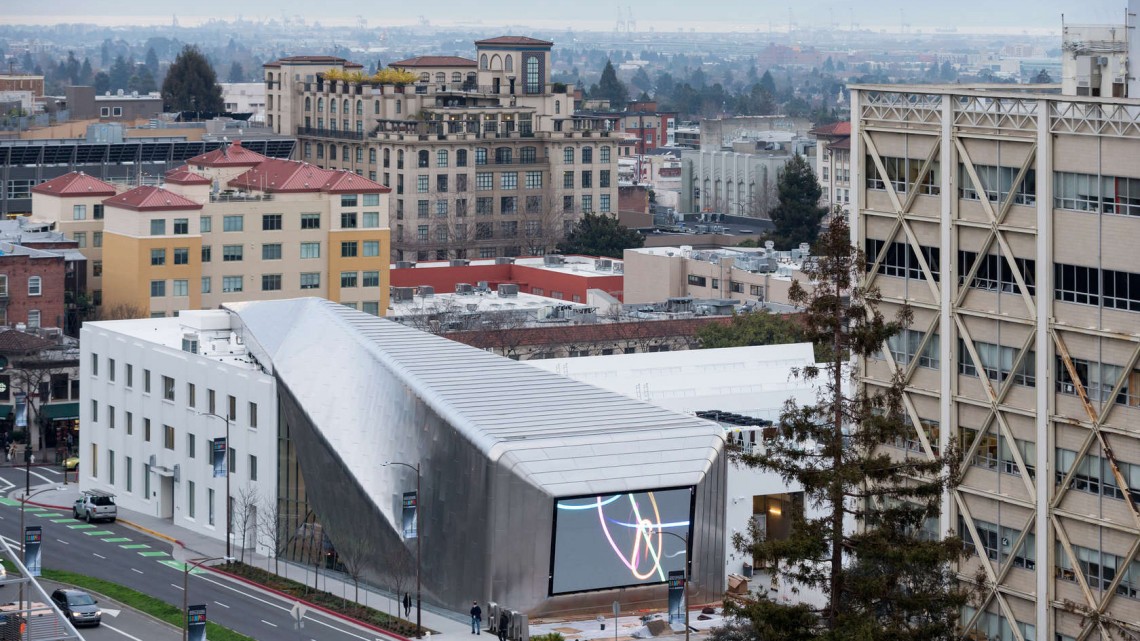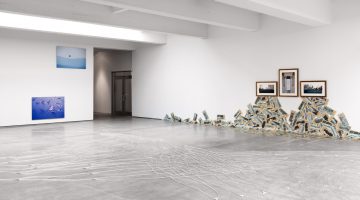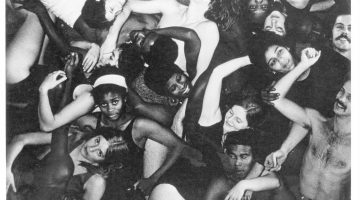The following interview took place January 8, 2016 at the University of California Berkeley Art Museum and Pacific Film Archive (BAMPFA). Lawrence Rinder is the Director of BAMPFA, and Constance Lewallen is an Adjunct Curator.
You curated Architecture of Life, the exhibition that reopened BAMPFA in its new building. In similar cases, museums ordinarily feature their collections. Why did you decide not to do the same?
We’re really seeing all of 2016 as our “Grand Opening Year,” and over the course of the year we will have several exhibitions that highlight various areas of our collection. For the opening show, I wanted to do an exhibition that would be bold, original, and breathtaking, and that celebrated the occasion of new architecture. I see it as an opportunity to connect with other institutions around the country and the world. Our new location on Center Street, one block from the Downtown Berkeley BART station and across the street from the main entrance to the UC campus, is so much more accessible and connected. That spirit of connectedness is part of our new reality, and, therefore, pulling together a show that puts us in dialogue with other organizations and other parts of the world is more in the spirit of the new building than a show that looks inward.
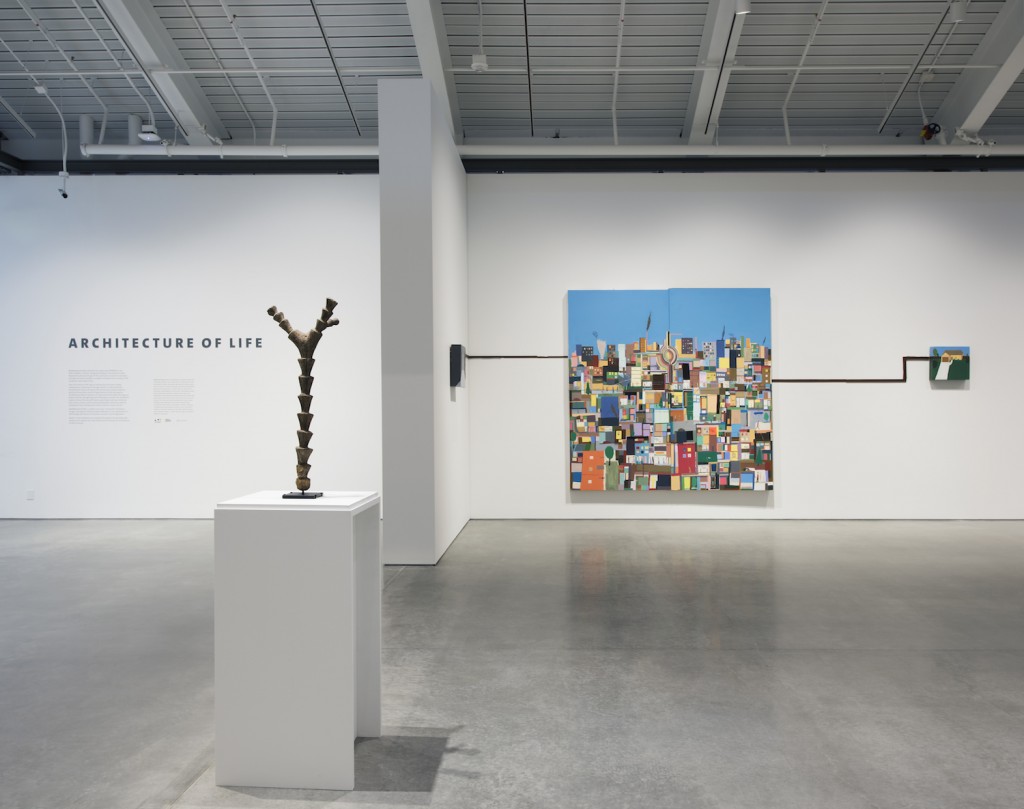
Architecture of Life, on view at the University of California, Berkeley Art Museum and Pacific Film Archive, January 31–May 29, 2016. Installation view, with a Dogon ritual altar ladder (left) and a work by Chris Johanson (right). Photograph by Sibila Savage. Courtesy of UC Berkeley Art Museum and Pacific Film Archive (BAMPFA).
That makes perfect sense. I imagine also that a multifaceted exhibition such as Architecture of Life reflects BAMPFA’s collection and mission, that is, as a comprehensive institution that reaches across cultures and time periods.
Right. Our collection goes back to 3000 BCE in Asia, and to the Renaissance in the West. Jackie Baas’s show Berkeley Eye, which opens in July [Berkeley Eye: Perspectives on the Collection, on view July 13 through December 11], will be a comprehensive collection show. Following that, we will present your show, Mind over Matter [Mind over Matter: Conceptual Art from the Collection, on view October 19 through December 23], which is focusing on our conceptual collection. Julia White, our senior curator for Asian art, is organizing three consecutive exhibitions beginning in July—one focusing on historical Chinese painting, one focusing on historical Japanese art, and another on historical Indian art. Lucinda Barnes, our Chief Curator and Director of Programs and Collections, is working on a couple of ground-breaking Hans Hofmann exhibitions. The opening year will include other non-collection shows as well. Apsara DiQuinzio, our Curator of Modern and Contemporary Art, and Phyllis C. Wattis, MATRIX Curator, has a number of wonderful small-scale MATRIX shows in the works, and we are doing several borrowed solo exhibitions that are emblematic of the kind of art that we love, such as a survey of Ana Mendieta’s films [Covered in Time and History: The Films of Ana Mendieta, on view November 9, 2016, through February 12, 2017]. This show is coming from the Katherine E. Nash Gallery at the University of Minnesota, but is very much in the spirit of BAMPFA, not only because Mendieta was a great artist, but because it’s very cutting edge work—it’s film in a gallery context, and it’s work that’s never been shown before, at least not so comprehensively. The Martin Wong show [Martin Wong: Human Instamatic, exhibition dates tba], was originated by the Bronx Museum of the Arts. This is the first retrospective exhibition of this important Bay Area artist. Also, in February 2017 we will present Hippie Modernism: The Struggle for Utopia, which we worked on in association with the Walker Art Center. This exhibition is emblematic of who we are in terms of its interdisciplinary nature and also because it digs deeply into an important local history with global resonance. We are not a local or regional museum—we’re a global museum with a local perspective, a unique Berkeley point of view.
As you know, BAMPFA has an incredibly rich film program. We will be doing as many of 450 screenings each year in the new building. We are going to a 52-week schedule and will have films every night the museum is open—Wednesday through Sunday—as well as weekend matinees. Some highlights include the inaugural series, Cinema Mon Amour, which will present classic films from around the world, many of which have been selected by local art and film celebrities. This year, our film program will also feature several wonderful series including Documentary Voices, the annual African Film Festival, and a Maurice Pialat retrospective, among many others.
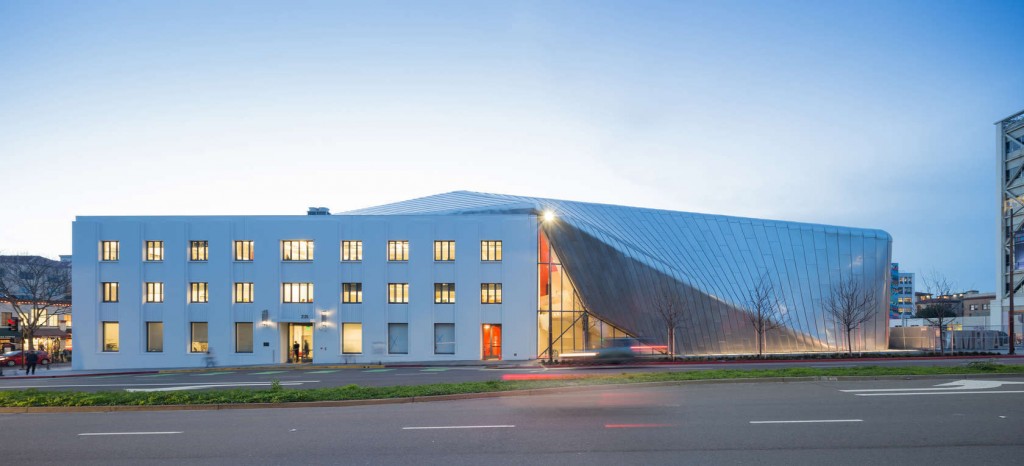
Diller Scofidio + Renfro, UC Berkeley Art Museum and Pacific Film Archive, 2016. View of the Oxford Street facade, with 1939 Art Deco administrative building at left and new stainless steel–clad theater at right. Photo by Iwan Baan. Courtesy of Diller Scofidio + Renfro; EHDD; and UC Berkeley Art Museum and Pacific Film Archive (BAMPFA).
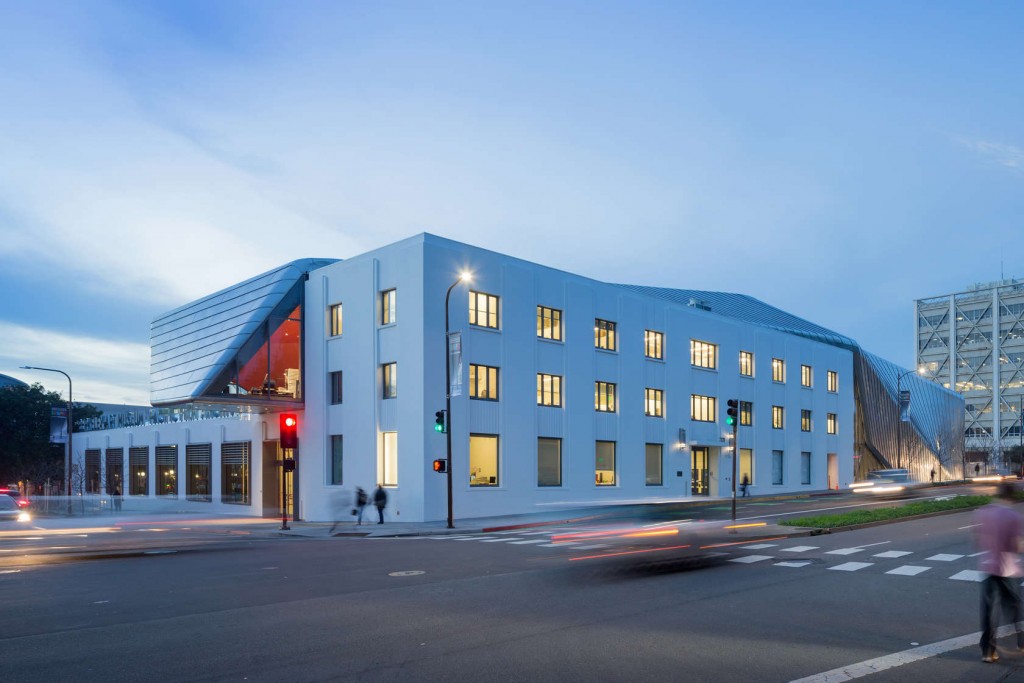
Diller Scofidio + Renfro, UC Berkeley Art Museum and Pacific Film Archive, 2016. View from Oxford and Center Streets. Photography by Iwan Baan. Courtesy of Diller Scofidio + Renfro; EHDD; and UC Berkeley Art Museum and Pacific Film Archive (BAMPFA).
With Architecture of Life, were you also intending to broaden the concept of what can be considered art? For example, you have many scientific works like nineteenth-century German physicist Otto Lehmann’s microscopic view of liquid crystals and the original Wow! Signal.
Yes, but certainly I am not the first person, nor is this the first institution, to question what art is—this has been going on for quite awhile—but I do think that museums haven’t taken as much productive or creative liberty in this regard as they might have. We all know that the boundaries are blurry.
I try to avoid that phrase [laughter].
But nonetheless, it’s a meaningful phrase. The boundaries are indeed blurry between art and many other things. What if one did allow oneself the latitude to elbow into adjacent territories? I think that’s what this show does. Some of the material in this exhibition is categorically not art, such as the Wow! Signal. There are other things that one could say are ostensibly scientific, such as Santiago Ramón y Cajal’s neurological drawings, or the Ernst Haeckel drawings—yet both men were artists who also happen to be among the greatest scientists that ever lived. I believe in both cases their scientific achievements were due in part to their artistic proclivities, their way in seeing holistically, and their ability to render detail in a way that I think helped them see the essential nature of the things they were studying. That kind of connection is not well known and is quite underappreciated. In the case of something like the Wow! Signal . . .
Which is?
The Wow! Signal is possibly the first documented extraterrestrial communication. It was a product of the SETI program, which stands for Search for Extraterrestrial Intelligence, which is a very well-funded and serious scientific effort to turn the antennas of the world out into the universe to search for signals that would suggest the presence of intelligent life. In 1977, Jerry R. Ehman, an amateur astronomer at one of the SETI stations at Ohio State University, was reading the computer output from the radio telescope which at first seemed to be simply the usual random numbers. But then he noticed on the sheet a dozen or so numbers and letters that were not random. It was amazing that he noticed it, because it was like a needle in a haystack. He drew a circle around them and wrote “Wow!” in the margin. Astronomers could tell that the signal came from Sagittarius, that region of the sky, but it was never detected again. I believe there is something about his acuity of vision that allowed Ehman to discern that needle in a haystack; there’s also something about the sense of wonder and improbability and the way that that moment of awareness has the potential to reshape our entire understanding of reality that I find is commensurate with the experience of art. It’s not art, but it’s like art.
Also, this is somewhat obvious, your exhibition and catalog affords such a great opportunity to connect with so many parts of the campus. When people ask me about BAMPFA and what distinguishes it, I always say it’s the connection with the university’s brainpower and amazing material resources.
That is true, and I’ll get back to that in a minute, but because of our location, our proximity to BART and downtown Berkeley, we are going to have a much larger and more diverse audience than we have ever had. One of my goals for this show is that there be something for everybody. It’s a very diverse exhibition and not everyone is going to like everything, but I will guarantee that in this show each visitor will find at least one thing that will blow them away, something—at least one thing—that will change them or spark something profound.
Among my other goals for the show—besides blowing people away—was to embody one of the essential characteristics of BAMPFA, which is that we are quasi-encyclopedic, that is to say our collections are not just modern and contemporary but rather contemporary, historical, and global. I wanted to really underscore in people’s minds that we are more than a museum of modern and contemporary art. We include lots of fantastic historical collections and programs.
As far as the campus is concerned, you are absolutely right that one of the things that makes us unique is our connection to UC Berkeley—we are the only visual arts museum at UC Berkeley. Berkeley is one of the greatest universities in the world, with a fantastic faculty across many disciplines, and we are one of the few places where the public can access that intelligence and also the material richness of the university. Now that we’re downtown right next to BART and opposite the main entrance to campus, I would love it if we became something like the front porch of UC Berkeley, where people can come and hang out formally and informally with the faculty. It’s the nature of the university to be multidisciplinary, if not interdisciplinary, and I want the exhibition to also capture that kind of universality of exploration, inquiry, and curiosity that the university embodies. So, yes, because of the presence of scientific material, also musical scores, and works that relate to literary themes, faculty from different departments will give lunchtime talks in the galleries about individual objects. There’s also an undergraduate course, called Big Ideas, being offered in conjunction with the exhibition that is open to the public. It’s an interdisciplinary course being taught at BAMPFA by Shannon Jackson, UC Berkeley’s first Vice Chancellor of Arts and Design, and UC Berkeley Professor of Architecture Nicholas de Monchaux. It’s unusual for the public to have access to an actual university course, in this case, one developed around this exhibition.
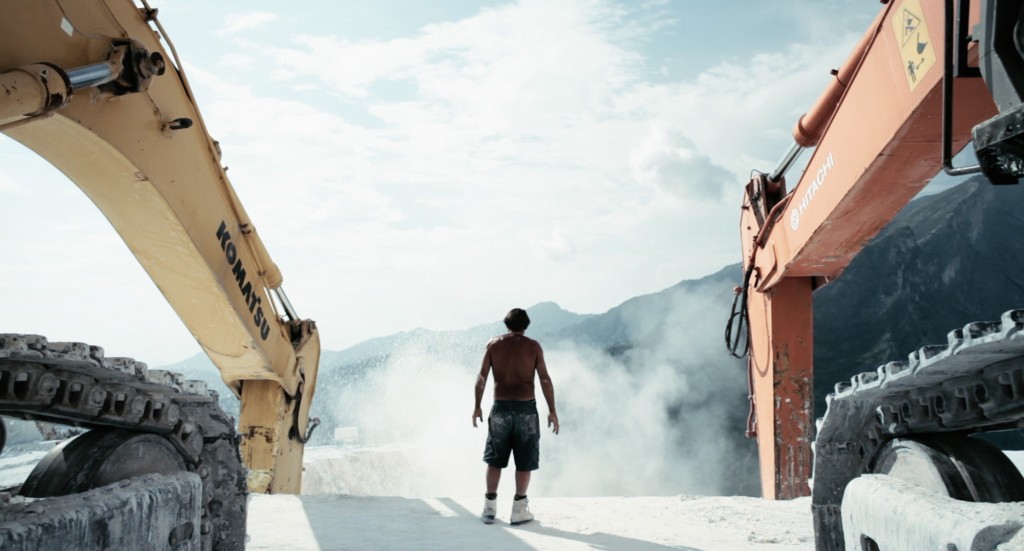
Yuri Ancarani, still from Il Capo, 2010; 35mm; color, sound; 15 min.; courtesy of the artist and ZERO…, Milan.
From the curatorial standpoint, what was the most difficult part of organizing Architecture of Life?
Well, there were lots of difficult things. It was difficult to be told ‘no’ when I asked for loans. That’s always hard. There were works of art that I felt would be just really wonderful in this context that I couldn’t get them for various reasons, either they were too fragile to travel or for some other reason. No one is going to miss these things except me, but it’s a very long and complicated process. You start with your wish list, and then you winnow it down. Sometimes you realize that the thing that you wanted so badly really wasn’t that important after all, and the thing that came in at the last minute is the link to the entire exhibition. I’ve been working on shows for thirty years, you’ve been working on shows for longer than that, so you know that there’s a certain—probably magic is too strong a word—but there’s something that happens in the process of putting a show together that can’t be preconceived. It happens in the winnowing and in the installation when the show takes on a life of its own, and it starts to tell you things.
That is what one hopes for.
Yes, that is what one hopes for. I hope that the things that I’m learning will be legible to other people as well.
Or different things will. A veteran curator once told me when I was lamenting my inability to secure a certain loan that people don’t miss what’s not in a show.
Right, they don’t generally, not in a show like this. If it was a Matisse retrospective and you didn’t have his Red Studio people might say “hmm.” I gave some tours as the show as it was going up, and people have asked, “How did you decide what to put in and what not to put in?” It is a good question. It’s a process. The theme, which is architecture, is a metaphor for life experience—the architecture of the mind, the architecture of society and so on. It’s a very deep and potent metaphor, and I think that on a certain level it’s something that, in a George Lakoffian way of thinking, it’s a metaphor that structures our mind, our cognition. The idea of architecture is very deep because it’s so essential to our survival. Buildings provide shelter and architecture organizes our lives physically. The metaphors of architecture, of space and connection are just so ingrained in our language and our experience that it’s very easy to find that resonance throughout art, art history, across cultures, and in adjacent territories like music, science, what have you. That did make it somewhat daunting initially to say, okay, what is the narrower universe that I’m going to look at? I decided that I would start with the criterion that I mentioned before, that I wanted every single thing in the show to be amazing, and to include a variety of works so that it wasn’t all in the same register, not all minimal, not all conceptual, not all representational, but very diverse so that it represented the diversity of what I hope our audience will be.
Also, the design of the building reflects the desire to bring the art and film programs more closely together. I refer to the fact that there is now a single entrance for art and film, which was not the case in the Bancroft building. In addition, the galleries stay open later and it is hoped that the film audience will get more involved in the visual arts and vice versa.
I’m very happy that our galleries will be open until 9 p.m., Wednesday through Sunday. I don’t know of another art museum that has late hours every day it is open.
I believe there’s never going to be a complete overlap in the film and art audiences, but you can provide for the possibility.
We also don’t want to make film and art the same thing. We’re not a museum of things that are both film and art, which I think is what some people think. “Oh, you’re film and art so it’s all going to be video installations.” No. We are just as happy to do a gallery show of oil paintings and a fantastic Rossellini retrospective shown in the wonderful new film theater. We try to do the best possible job presenting in whatever medium that we’re working with, whether that’s performance, painting, prints, or film. We strive for excellence across all media. We are unique, I think in the world, as far as I’m aware, in that our film and visual arts programs are roughly equal in size. We have the same number of curators for film as we do for art. We have the same number of films in our collection as we do art objects. We historically have had about the same number of visitors for the film program as for the art program. So in fact, this duality, which is embedded in our name, the Berkeley Art Museum and Pacific Film Archive, is realized in our collections, our programs, and our attendance. I believe that particular balance is unique. There are other museums that have fantastic film programs—MoMA in New York has a great film program and is closest to us in that sense. But at MoMA the film program is relatively small in relation to the art programs, whereas our identity is really about parity between art and film. One of the things in the new building that expresses this architecturally is that we have increased the number of screens. We used to have just one screen. We had many galleries, but one screen. Now we have three screens, two indoor and one outdoor. As you were saying, it’s integrated.
Historically, I think it’s always been a bit of a problem that the film program had its own title. In most museums, MoMA being the example that we mentioned, the film program is a department within the museum. Here, for reasons I used to know, but don’t remember, Pacific Film Archive had its own name and therefore its own identity, which at times causes confusion.
It is confusing, and it’s a historical artifact based on the fact that way back, and I’m talking like 1960s, there was something called the Pacific Film Archive, which very soon after it was created was absorbed by the museum. But it kept that name within the museum. It has not been an autonomous entity since 1970 or something like that. And at this point there is no distinct entity called the Berkeley Art Museum, there is no distinct entity called the Pacific Film Archive, there is just the Berkeley Art Museum and Pacific Film Archive. So we are one institution with a dual focus on art and film. BAMPFA has film curators and art curators, a film collection and an art collection. That is how we operate and how we understand our identity.
The film collection is renowned, as we know, an especially distinguished collection of Japanese films, Russian films . . .
Right, the largest collection of Japanese cinema outside of Japan, a very important collection of Soviet cinema, as well as silent film, and Bay Area avant-garde film. It’s a fantastically important collection, and not only the films themselves, but also the ancillary materials. We have about a quarter of a million books and periodicals; we have an archive of clippings. Just yesterday I was down in the library visiting the folks down there and seeing how they were getting settled in. They pulled out the file for the film The Graduate and there were the original press kit clippings, the first review—all of this great stuff. We have films going back to the very beginnings of cinema, with original scripts, hundreds of thousands of pieces of documentation, most of which, by the way, has been scanned and is available to the public for free on the website. So if people type in BAMPFA CineFiles you can see scanned images of many of the things in our film archive.
How is the scanning of the collection going?
Well, it’s a work in progress. It’s not scanning per se; generally speaking it’s photography, the digitizing. It’s a critically important thing now for museums to digitize the images so they can be made accessible to the general public, to scholars and others. It’s very expensive. Every single work has to be done very professionally; it has to be color corrected, and then one has to enter all the metadata about the work—all of this information not only needs to be entered, but proofed. So just imagine that for each object it probably takes two days. We have almost 20,000 objects—and that’s just art. For the film, it is even worse. It costs about $5,000 to digitize a single film because unlike an art object, which you can hang on the wall, adjust the lighting until it looks right, and then take the photo, with a film someone has to sit there and look at the entire film, make sure there are no scratches. It has to be color corrected, too. Therefore, we had to do triage to decide which of our children do we value the most and which can we afford to scan. Luckily we have a very good curatorial staff that was able to weigh all the variables having to do with rarity and risk to prioritize which films to send out for conservation and digitizing. We’ve recently acquired a machine that will enable us to do the film digitizing in-house, which will be an incredible help for us. We can build it into the workflow now; it can just be part of what happens in the daily work of the film curators and archivists. One of my goals, once the dust settles on the new building, is to build into the workflow the photography of the collection.
In the past every time a work came into the collection it was professionally photographed, but then at some point that no longer occurred, probably for budgetary reasons. Instead, a preparator took a snapshot.
Snapshots are fine for identification, but that’s not what you put on the website. There are probably a couple thousand artworks in the collection that are digitized, so that’s a fairly significant number. We have received grants to digitize the conceptual art collection and the nineteenth-century photography collection; Indian miniatures have all been digitized, the Hans Hofmann paintings are all digitized, and many other things. We are looking forward to our new Collection Portal, a digital touch screen that will enable people who come to BAMPFA to access images and information about works in the collection, both still and moving images.
I look forward to that. Is that going to happen soon?
The screen is up now but won’t have interactive capacity until July when Jackie Baas’s collection show opens.
Do you see BAMPFA as being in competition with other museums?
No, I mean, you know, there are so few museums in our area, how can we be in competition? I’m very grateful for the museums we have, but we do not have enough museums in this region, let alone in San Francisco and Berkeley, to in any way scratch the surface of all the great art that there is to see . . . the more the merrier, as far as I’m concerned. On the other hand, there is a kind of natural ecology that emerges from the balance among different institutions in a particular region. The way that we function in the context of SFMOMA, the Fine Arts Museums, and the Oakland Museum, is probably different from how we would function if none of those institutions existed. We adjust, we probably move more in some directions than in others. There is recognition of this ecology, but I wouldn’t call it competition.
One thing that museums are always trying to do is to attract a young audience. Often they do this through parties and singles nights, and yet in general most museum-goers tend to be older, perhaps because they have more time—whatever the reasons. Is there an increased attempt to bring in families? Is that a priority?
Yes, we’re excited and prepared to welcome these more diverse audiences. Because we are the only encyclopedic museum that is accessible by BART, people are going to come here. For example, we have hired a new permanent staff person who focuses on programs for school kids and families, mostly for things that happen at BAMPFA, although we are also doing programs in the community. This past fall we did collaborative projects at the Richmond Art Center and the Cerrito Theatre that were meant to introduce BAMPFA to West Contra Costa families. It’s one of our goals to tap into those communities in particular. I think the Oakland Museum does an absolutely fantastic job of serving schools and families in Oakland, but in our new location we are now the most proximate museum to the West Contra Costa communities, including Richmond and El Cerrito. We want those communities to know that they can count on us, that we will have programs for them in both art and film.
We are planning all kinds of things for families from gallery tours, family days, family gallery guides, and a drop-in art lab for all ages. The Koret reading room, which has a collection of books about our exhibitions, as well as poetry and fiction, is designed for all ages with books for children as well as adults. It will even have child-size furniture. I think both in the Art Lab and the Reading Room, we are really sending the message that this is a place for people of all ages. There is not a separate place in the building for children, so everybody can hang out together and enjoy art together, whether it’s in the galleries or in these special spaces. We are free for visitors 18 or younger, and if you’re 18 or younger you can bring a guardian with you who comes for free; that is one guardian per young person. These are the multiple ways that we are reducing the barriers to attend and increasing the opportunities.
I know that university museums in general have always struggled to increase their student attendance. I think we are one of the more successful at that, but probably not as successful as we would like to be. Do you think that this location will enhance the student attendance? For one thing, we’re physically farther from the art practice and architecture departments. Do you think that will have a negative impact?
Our goal is to impact as many Cal students as we can across as many disciplines as possible. We believe that engagement with art and film transforms young people’s lives in a positive way, and has a positive effect on their classroom learning in any discipline, whether they’re in engineering, physics, English, or art. So being immediately opposite the main entrance to the campus is the right place for us, because we belong to the entire campus. There are some recent changes in the curriculum at Berkeley that have dramatically changed our relationship, particularly to the undergraduate population, and we have gone from the situation that you described, which I think is, unfortunately, the situation of most college and university museums, that is the struggle to find a student audience. Thanks to a new program at Berkeley called Berkeley Connect, which creates a structure through which freshmen and first-year transfer students are incentivized to discover the cultural resources of the campus and the community. We have gone from being in the same position as all the other college and university museums, struggling to get enough students, to having almost more than we can handle. We have increased our staffing in the area of student engagement. We hired a new position of collections engagement associate who will add to our academic liaison position in helping to serve individual student and class audiences. We are in a really fantastic position because this new program has really created a structure that is kind of a pipeline that just brings lots of students from all across the campus to the museum for engaging connections with art. It’s kind of a dream come true for us.
Well speaking of staff, I know that SFMOMA has increased its staff in the run-up to the opening of their building, but we have actually reduced staff.
We reduced our staff temporarily. When we were closed—the galleries were closed for a year, the film program was closed for six months—we did reduce staff whose job was to interact with the public. We are now hiring in a number of areas that have to do with visitor services and audience engagement in anticipation of an increased attendance. The education department has grown more than any other department. In terms of overall full-time positions, the total number of staff members, once we’re fully ramped up will be about the same, if not slightly more than in the former building before the closure. We had a dip in staff because of the move and now we’re ramping up, while not a dramatic increase like SFMOMA, which has doubled the size of their building. Our building is 20% smaller than the former building, so our staff increases don’t have to do with having to deal with a bigger building. We don’t have to hire more technicians to deal with more light fixtures or whatever. It’s really just about the people. It’s a more efficient building with more versatile galleries that are more strategically located to be accessible to more people.
What do you think is lost in this new building as compared to the former?
The only thing that I’ll miss is the opportunity to do large-scale performative events. We had that 7,000 square foot atrium in the Ciampi-designed building that enabled us to do concerts or dance performances with audiences of up to 1,000 people. Because of the architecture you had very unusual vantage points—you could go up above and look down or across. I’ll miss that, but you know, we couldn’t afford to build a 7,000 square-foot atrium. We had to prioritize.
Also, that atrium was primarily good for performance, not for visual art.
Right. It was a wonderful space when it was filled with hundreds of people. When it was not filled with hundreds of people it was like a wind tunnel or something. It made it feel like the museum was empty even if it wasn’t because it was such a vast space. So we have created a kind of miniature version of that atrium in the new building, the Crane Forum, which is right off the main entrance, which has a seating amphitheater designed by Paul Discoe, the Japanese joiner, architect, and designer. We have a small stage area where we can present informal performance events, like we did in the former building, but we won’t be able to do programs that have such a huge audience.
Could you use spaces on campus, maybe?
We could, but what we’re going to do instead, is develop a performance program that fits within the unique parameters of our new building. I loved the L@TE program that we did for five or six years in the old building, but because this building is different we’re doing a different kind of program called Full. Full will occur every full moon in the evening, whether we’re generally open or not. We’re open normally Wednesday through Sunday, so if a full moon falls on Wednesday, Thursday, Friday, Saturday, great, but if it falls on Monday or Tuesday we have to open anyway, because the moon dictates. The good thing about this is that we don’t have to advertise because the full moon is its own advertisement. If the moon is full, come to BAMPFA! Instead of a single headline act, the kind of thing that we used to do, our approach is going to be more like Sarah Cahill, who has been doing every solstice at the Columbarium in Oakland, where she programs dozens of performers throughout the Julia Morgan Mortuary in Oakland, in all the crypts. They are all playing simultaneously—it’s just an incredible, kind of wonderful strange cacophony. One of the great things about our new building is it does have a number of little open spaces that you discover as you’re wandering through. We are taking advantage of that, and for Full we will have multiple performers performing in different parts of the building on every full moon. Sarah Cahill is programming the first season, this spring we’ll have four Full nights that Sarah will arrange—multiple, sometimes simultaneous, performance in different little nooks and crannies.
What is your sincerest wish for the new BAMPFA?
My sincerest wish is that it be beloved by the entire community, that it be provocative, and nurturing, if one can be both of those things, and that it really serve, as I said, as a front porch of the university, increasing that connection between campus and community. I guess you could say on the deepest level I hope we change lives for the better, and I believe we can.
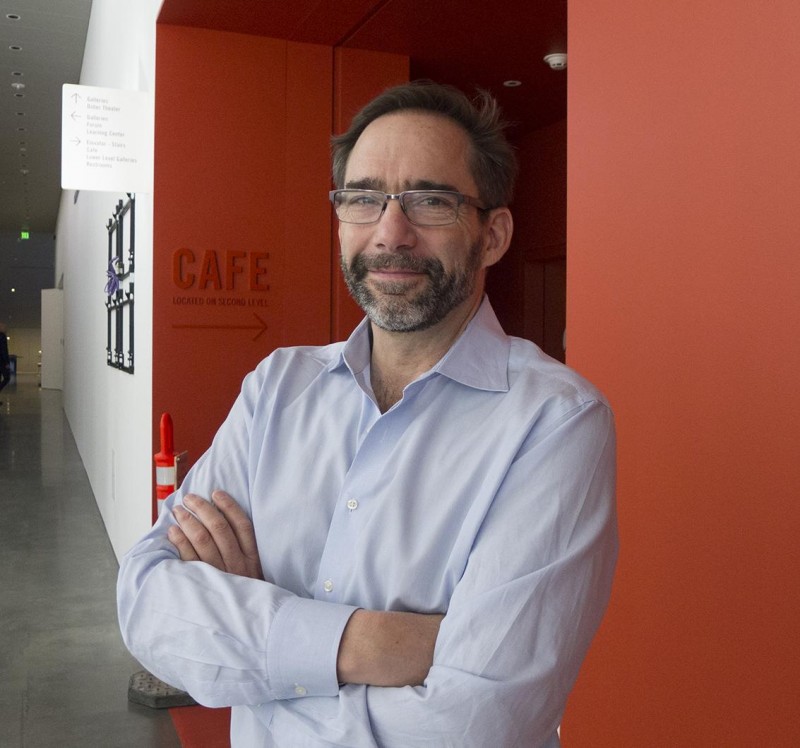
Lawrence Rinder photographed by Peter Cavagnaro, 2016. Courtesy of UC Berkeley Art Museum and Pacific Film Archive (BAMPFA).
How do you feel about the Bay Area as an art center? We all know the problems with gentrification. Can the Bay Area continue to be a vital art center?
Obviously, the Bay Area has some serious problems in regard to gentrification. We’re lucky in the sense that because UC Berkeley is a public university the student body is incredibly diverse. Something like 30% of the students at Berkeley qualify for Pell grants, which means they come from families that earn $45,000 a year or less, so while the rest of the Bay Area is losing the diversity of its population in economic terms, we have a semi-guaranteed stability, relatively speaking. We know that we will always have diverse audiences here, at least among the younger student populations: diverse in terms of economic backgrounds, diverse culturally, ethnically, and from place of origin, which is fantastic. I worry about the rest of the Bay Area because the audiences are becoming homogenous, and artists are being forced out.
It seems to me if you’re a young person graduating from one of the many art schools, one of the strengths of the Bay Area, as we all know, are the many opportunities for an art education. However, nowadays most art students leave once they graduate. They simply can’t afford to stay, unless, for example, they get a teaching job.
Even if they do find a teaching job, how can you afford to live in the Bay Area with a teaching job? It’s really terrible. I don’t have an answer, I’m afraid.
Do you think the fact that the Bay Area is a center for new technology that will eventually have a positive impact on the art scene? Maybe some of those young entrepreneurs will begin to embrace and support the fine arts?
They might or they might not. I think that’s a different question from how artists are going to be able to live here. It could turn out that a substantial amount of the tech wealth becomes engaged with culture, which would be all to the good as far as I’m concerned, and I think that is going to happen. I think it’s inevitable that some percentage of that money and that wealth is going to come to cultural institutions like ours, and will support programs and collections, and that’s great. But that is not going to solve the problem of the grassroots level creativity. We’ll still have art schools here so there will be creativity at that level, but then there will be a gap between the ages of 22 and 45—you probably won’t find many artists in that age range left in the Bay Area.
I am optimistic in hoping that because this has always been an area for cultural and social innovation that somehow something positive will evolve that we can’t now predict.
I see things happening that I think are positive. Autodesk, for example, has art studios and art making labs right in the middle of their executive offices, but it’s not open to the public. Even though there are quite a number of artists are involved in that program, it’s infinitesimal on the scale of an entire multimillion-person population. It can’t replace the flight of an entire generation of artists.
Also, the Minnesota Street Project developed by Deborah and Andy Rappaport, which will offer galleries and studios at below market rate.
It’s a fantastic initiative, but we need a hundred of them.
Exactly, that’s what I always say; it’s a fantastic addition to the Bay Area, but we need a hundred of them to make a real dent.
